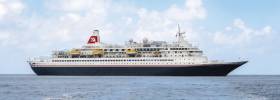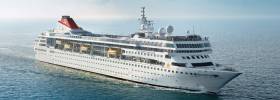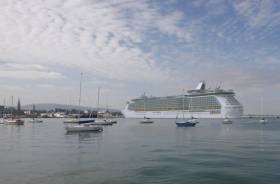Displaying items by tag: Cruise Liners
#CruiseBerth - The Save-Our-Seafront Dun Laoghaire group was yesterday granted leave by the High Court to challenge An Bord Pleanala’s decision to approve cruiseships docking in the local harbour.
As The Irish Times reports, the group, which is an environmental non-governmental organisation chaired by local TD Richard Boyd Barrett, claimed that the environmental effect of the proposed cruise berths were not adequately assessed by the Board.
Mr Justice Max Barrett granted the group leave to judicially review the Board’s decision on a number of grounds.
The court heard that independent environmental impact studies were inadequate and as a result the Board had not lawfully discharged its obligations under Irish and European planning laws.
Counsel for the group said the Board should have conducted an independent and separate assessment before having given its decision without merely relying on the information provided by the Dun Laoghaire Harbour Company.
The court heard there had been a failure by the Board to conduct surveys relating to the effects on summer and winter birds and the impact on the Minke Whale population, a species listed in the Habitats Directive, and as a result of which its decision was further flawed.
Mr Justice Barrett heard that the harbour company proposed to dump the dredge spoil from the navigation channel into the sea on the Burford Bank which was within the Rockabill to Dalkey Island special area of conservation, an off shore reef vulnerable to toxins.
The group also alleged that given the toxic profile of the dredge spoil the harbour board was obliged to consider the impact of the dumping of spoil in all local special areas of conservation in Dublin Bay and Rockabill which it had not done.
It stated in an affidavit that the harbour company had failed to consider the cumulative effects on marine mammals or sea birds from other proposed or permitted developments within Dublin Bay.
The newpaper has more on the story here.
#CruiseBerth - The Irish Times writes that a judicial review of An Bord Pleanála’s decision to approve facilities for cruiseships in Dún Laoghaire Harbour will be sought in the High Court on Thursday.
The campaign group Save our Seafront, which is taking the challenge, says last November’s decision by Bord Pleanála restricted the size of ships but still left open the possibility of the harbour being usurped by cruise liners.
The board granted permission to Dún Laoghaire Harbour Company for an €18 million development to build a new pier and dredge a navigation channel through the harbour mouth, as well as developing a turning circle outside the harbour. But the board ruled the size of ships permitted to enter the harbour should be restricted to 250m in length, rather than the 340m limit sought by the company.
The chairman of Save Our Seafront, local TD Richard Boyd Barrett of the Anti-Austerity Alliance-People Before Profit, said the development approved by the board could still result in a significant loss of amenity to existing harbour users. He said the board’s decision did not properly take into account the environmental implications of dredging and other aspects of the plan.
Save our Seafront is to ask the court to grant a judicial review of the decision on the basis of two points.
To read more including an Environmental Impact Study (EIS) of proposed development click here.
#€40thousandEgg! - In the penultimate episode of 'The Local Eye', The Donegal Post team visit a luxury five star cruise ship docked in Killybegs but can boss Chris keep social diarist Gabrielle away from duty free long enough to get the story?
And will the €40,000 Faberge Egg they find go onto Gabrielle’s Christmas List?
To find out more about the expensive egg!... watch The Local Eye, it's on tomorrow night, Thursday, December 22nd on RTÉ One at 7pm
Killybegs continues to develop the cruise business which is a relatively new sector that has attracted famous lines. Among them Holland America Line (HAL) which called in September (see report's photo) followed by next port of call 'albeit' anchorage in Galway Bay.
The cruiseship calls to Killybegs will be given another boost given Cunard's announcement to deploy both 'Vista' class sisters in 2018. The sisters are the 90,000 tonnes Queen Elizabeth and Queen Victoria.
The north-west port has relied heavily on the more traditional fishing industry which was followed by that of the energy and exploration sectors.
Quartet of Cruiseships Coming to Cork for Christmas
#CobhChristmasCall - A quartet of cruiseships will come to Cork Harbour this festive season, including one on Christmas Day, bringing 5,000 visitors to the region.
The increase writes the Evening Echo in winter cruiseships highlights a changing industry. Cork traditionally welcomes cruiseships into Cobh from April to October, and 58 vessels arrived this year.
The larger ocean liners are then redeployed to the Caribbean, the Meditteranean, or to the southern ocean around Australia. However, increased competition means vessels operated by UK and German cruise companies are continuing in northern Europe throughout the winter.
Earlier this week, the Bodicea called to Cobh and will be followed by the Balmoral, on Saturday, and the Marco Polo, on Monday. Then, on Christmas Day, Black Watch, operated by Fred Olsen Cruise Lines, will come to Cobh. The four vessels have a capacity of 5,600 passengers and crew.
For more from Captain Michael McCarthy, the commercial manager of the Port of Cork, click here.
Historic First Cruiseship Caller to Drogheda Port to Undergo Major Works to Extend Career
#MajorUpgrade - Polar small cruiseship operator, Quark Expeditions’ whose Sea Adventurer under another guise made a historic first but only cruise call visit to Drogheda Port is to undergo a major renovation, writes Jehan Ashmore.
The former Clipper Adventurer then on charter to Noble Caledonia made the historic occasion by berthing on the Boyne as Afloat reported in 2012 (scroll down for photo) is to undergo a major $8.5 million investment. The project involves renovation and upgrade work beginning in April 2017 at the Ulstein Verft in Norway.
The extensive works to the 4,367 gross tonnage Sea Adventurer will not just be focused on passenger facilities of the 132 traveller /83 crew run ship but significant technical enhancements – including two new engines – to improve fuel efficiency and minimize carbon footprint.
Passenger areas are to recieve a new look and feel throughout with a forward lounge and observation deck to enjoy mesmerizing polar views be it the Arctic or Antartica. As for accommodation, alterations are to include some new cabins and every cabin will get a new bathroom.
On completion of the dry-docking works, she is to emerge as the renamed Ocean Adventurer with a renaming ceremony to take place on 17 June next year for Quark, part of the TUI Adventure Division.
The works are more the remarkable given the veteran vessel has been in service for four decades having been built in 1976 at a Yugoslavian shipyard as the Alla Tarasova. Originally the Russian ship served as a coastal passenger ship for the Murmansk Shipping Company.
To embark on such an investment is down to Sea Adventurer’s structural integrity given a robust ice-strengthened hull. She is one of an octet of similar ships. It was Clipper Cruise Line that had the ship rebuilt almost a decade ago in 2007 for expedition cruising as Clipper Adventurer.
#Cranes&Cruises – Two ports in south Wales operated by Associated British Ports (ABP) have invested over £2.8 million in the refurbishment of five cranes at Newport and Swansea, writes Jehan Ashmore.
The work which took 14 months to improve operational efficiency and extend the lifespan of the cranes was carried out by Port Talbot based engineering company, Celtic Engineering. Among the products to be handled by the cranes are coal, aggregates, forest products and steel. The refurbishment also allowed for increased handling efficiency when loading and discharging vessels.
Afloat.ie has also been researching UK operator Cruise & Maritime Voyages (CMV) whose 1,250 passenger capacity flagship Magellan is to offer a direct departure from Newport located to the east of Cardiff. Cruise-goers in season 2017 can take a two-night Dublin Mini-Cruise in June or remain on the 46,000 gross tonnage vessel as part of a longer 11 nights Fjordland Splendour & Dublin Cruise. More on Magellan but that of CMV's move to offer direct cruises from the Irish capital will appear on our Cruise Liners news.
Further along the coast beyond the Walsh capital to the west is Swansea where the investment programme by ABP to upgrade cranes will be complemented by a new Mantsinen Hydraulic Crane due to be installed at the port next month. The crane forms part of a £6 million deal that will see five new cranes delivered across the UK port group’s network of 21 ports.
Swansea has strong Irish maritime connections given the former Swansea-Cork Ferries service that was followed by last incumbent, Fastnet Line that ceased operations in 2011. In more recent times at Swansea Dry Docks the shiprepairer and recycling facility was last winter the recipient of Cork based Mainport Group’s disposed seismic support vessel Mainport Ash.
#RecordOilFine- A US$40m penalty is to be paid by Princess Cruises after pleading guilty to seven federal charges in an illegal ocean pollution case that involved one ship’s use of a so-called 'magic pipe' to divert oily waste into UK waters, writes The Guardian.
Miami US attorney Wifredo Ferrer told a news conference the penalty was the largest ever of its kind. A plea agreement filed in federal court also requires Carnival, the UK and US-listed parent company of the Princess line, to submit 78 cruise ships across its eight brands to a five-year environmental compliance programme overseen by a judge.
Ferrer said the illegal practices came to light when an engineer aboard the Caribbean Princess discovered the “magic pipe” in 2013 off the coast of Britain and told investigators about it.
Authorities later learned the 952ft ship had been illegally discharging oily water into the ocean since 2005.
“Our open seas are not dumping grounds for waste,” Ferrer said. “One thing we must never do is take our clear blue oceans for granted.”
A single illegal discharge dumped 4,227 gallons of oil-contaminated waste about 20 miles off the coast of England on 26 August 2013, according to court documents.
The documents also show illegal practices were found on four other Princess ships, including use of clean ocean water to fool onboard sensors that would otherwise detect dumping of improperly contaminated bilge water. Authorities say cost savings was the motive and that the ship’s officers and crew conspired to cover up what was going on.
John Cruden, assistant attorney general for the US justice department’s environmental division, said the Caribbean Princess “violated the law, they covered it up and then they lied about it”.
“We’re sending a strong message in this case to the entire industry.”
To read more on a statement released from Princess Cruises click here.
In August this year Afloat covered the story of a power failure on Caribbean Princess bound for Dublin Port which rendered the vessel adrift for nine hours on the Irish Sea.
Afloat.ie adds that Caribbean Princess is to call to Dublin Port in season 2017 as the most frequent of any cruiseship with 13 separate visits. The giant 112,894 gross tonnage vessel with a guest capacity of 3,142 (lower berths) is scheduled to make the first call in April.
The Carnival subsidiary will also see Pacific Princess calling to Dublin. Described by Princess as the 'small cruiseship experience' given the 30,277 gross tonnage and only 672 (lower berths) capacity vessel which is to make three calls. Together these cruiseships will total 16 calls calling to the capital.
Celebrity Eclipse Is Revealed as Dublin Port's First Major 'Home Port' Cruiseship
#HomePort - Celebrity Eclipse has been revealed as the first cruiseship by a major operator to 'home port' in Dublin Port by offering cruises that begin in early summer 2018.
As previously reported on Afloat.ie Celebrity Cruises begins the ships home port on a mini season of five sailings in late April, throughout May and until the end of June 2018. The 'Solstice' class Celebrity Eclipse with a 2,800 passenger capacity will operate cruises departing Dublin Port to destinations throughout northern Europe. Full details on the destinations on offer will be announced later this year.
It is estimated that more than 14,000 people are to start their cruise holiday from Dublin on the Celebrity Eclipse. The deployment of the German built 122,000 gross tonnage vessel to the Irish capital is worth an estimated €6 million and to the surrounding region in knock-on economic benefits.
Celebrity Cruises already features Dublin and other ports throughout Ireland in its European deployment, however this is the most significant increase in its investment into Ireland in the history of the global business.
Charges for Cruiseships Waived by Rosslare Europort
#ChargesWaived - Shipping lines have been notified by Rosslare Harbour that it is to waive charges for cruise ships for 2017, 2018 and 2019. The initiative is to establish the south-east as a destination for what is Europe’s fastest growing tourism sector.
This follows the success of the arrival of the Fred Olsen Lines’ MS Braemar in July of this year, which was the first cruise ship to call to Rosslare in 20 years. Feedback from cruise passengers and crew was excellent, from the ease of arrangements with the Europort to the programme of activities and the warm welcome from representatives of Wexford County Council and Fáilte Ireland, supported by Visit Wexford
John Lynch, General Manager Rosslare Europort said “up to 400,000 tourists visited Ireland on cruises this year, and it is a sector which continues to grow rapidly. Europe-wide, the cruise industry contributed over €40 billion to European economies, supporting 350,000 jobs.
“We believe – and customers from MS Braemar agreed – that Wexford and the South-East provide a destination which would be an excellent inclusion in any cruise itinerary visiting Ireland. By waiving charges, and working with local authority and tourism colleagues on the Working Group I established to develop new cruise business for the Europort, we are confident we can build a consistent and sustainable business which will bring tourists, profile and, crucially, employment and income to the South-East.
“We are fortunate at Rosslare that not only do we have the capacity to operate as a busy commercial port, but we are also situated in an area of outstanding natural beauty and rich cultural heritage and I believe that there will be many more Cruise Ships that will want to explore the wonders of Wexford and the South East.
“Our waiving of charges is a first step – we want to establish long-term relationships with the many cruise line companies operating in Europe which will support the Europort and the region into the future.”
Since 2008, European cruise capacity has grown by 44%, a trend which shows no sign of abating.
Customers on the MS Braemar had availed of pre-arranged excursions throughout the Wexford Region including scenic drives and walks, and visits to Tintern Abbey, Wells House, Kilmore Quay, the Irish National Heritage Park and the Dunbrody Famine Ship in New Ross.
Cruise Berth at Dun Laoghaire Gets Go Ahead, But It's Not All Plain Sailing for Locals
#CruiseBerth - Mixed reaction from local businesses follows the decision to grant a new cruise ship berth with planning permission in Dun Laoghaire Harbour, writes the Herald.ie
The €18m development will allow ships of 250 metres in length to enter the port, paving the way for luxury cruise liners to dock at Dun Laoghaire. But locals are concerned that they will see little of the increased tourist trade promised by the development.
"It's going to put more nails in the coffin in Dun Laoghaire," said Andrew Ball, of Dunphy's Bar. "I personally don't think it's going to give us anything. People get on buses and go to the city - we don't see much of the benefit."
Neglected
Danielle Kelly, of Hicks butchers, said that anywhere away from the seafront has been "forgotten about".
"It was better when the boats from England were coming over on day trips. Most were originally from Dun Laoghaire or local and would stay here for the day," she said. "But now because they've stopped them they're all going out to town."
Declan Coates of Cameo Jewellers said that money might be better spent on developing the town. "It's lovely down on the seafront, but they've neglected up here on the streets," he said.
However, some locals were looking forward to added business from the cruise ships.
For more responses to the planning decision, the newspaper has more here.




































































